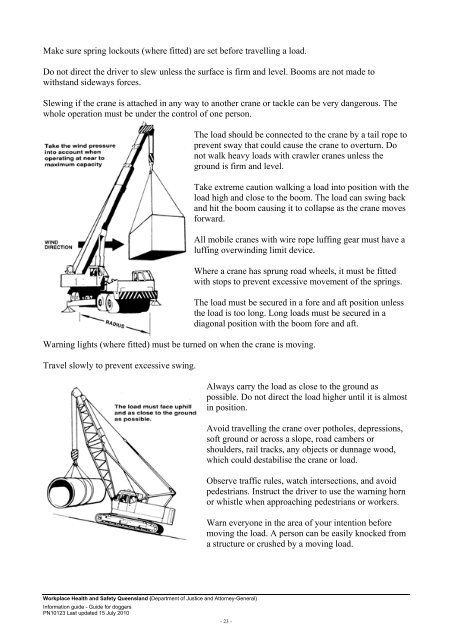+++guide-for-doggers-ODLICNO
Create successful ePaper yourself
Turn your PDF publications into a flip-book with our unique Google optimized e-Paper software.
Make sure spring lockouts (where fitted) are set be<strong>for</strong>e travelling a load.<br />
Do not direct the driver to slew unless the surface is firm and level. Booms are not made to<br />
withstand sideways <strong>for</strong>ces.<br />
Slewing if the crane is attached in any way to another crane or tackle can be very dangerous. The<br />
whole operation must be under the control of one person.<br />
The load should be connected to the crane by a tail rope to<br />
prevent sway that could cause the crane to overturn. Do<br />
not walk heavy loads with crawler cranes unless the<br />
ground is firm and level.<br />
Take extreme caution walking a load into position with the<br />
load high and close to the boom. The load can swing back<br />
and hit the boom causing it to collapse as the crane moves<br />
<strong>for</strong>ward.<br />
All mobile cranes with wire rope luffing gear must have a<br />
luffing overwinding limit device.<br />
Where a crane has sprung road wheels, it must be fitted<br />
with stops to prevent excessive movement of the springs.<br />
The load must be secured in a <strong>for</strong>e and aft position unless<br />
the load is too long. Long loads must be secured in a<br />
diagonal position with the boom <strong>for</strong>e and aft.<br />
Warning lights (where fitted) must be turned on when the crane is moving.<br />
Travel slowly to prevent excessive swing.<br />
Always carry the load as close to the ground as<br />
possible. Do not direct the load higher until it is almost<br />
in position.<br />
Avoid travelling the crane over potholes, depressions,<br />
soft ground or across a slope, road cambers or<br />
shoulders, rail tracks, any objects or dunnage wood,<br />
which could destabilise the crane or load.<br />
Observe traffic rules, watch intersections, and avoid<br />
pedestrians. Instruct the driver to use the warning horn<br />
or whistle when approaching pedestrians or workers.<br />
Warn everyone in the area of your intention be<strong>for</strong>e<br />
moving the load. A person can be easily knocked from<br />
a structure or crushed by a moving load.<br />
Workplace Health and Safety Queensland (Department of Justice and Attorney-General)<br />
In<strong>for</strong>mation guide - Guide <strong>for</strong> <strong>doggers</strong><br />
PN10123 Last updated 15 July 2010<br />
- 23 -



